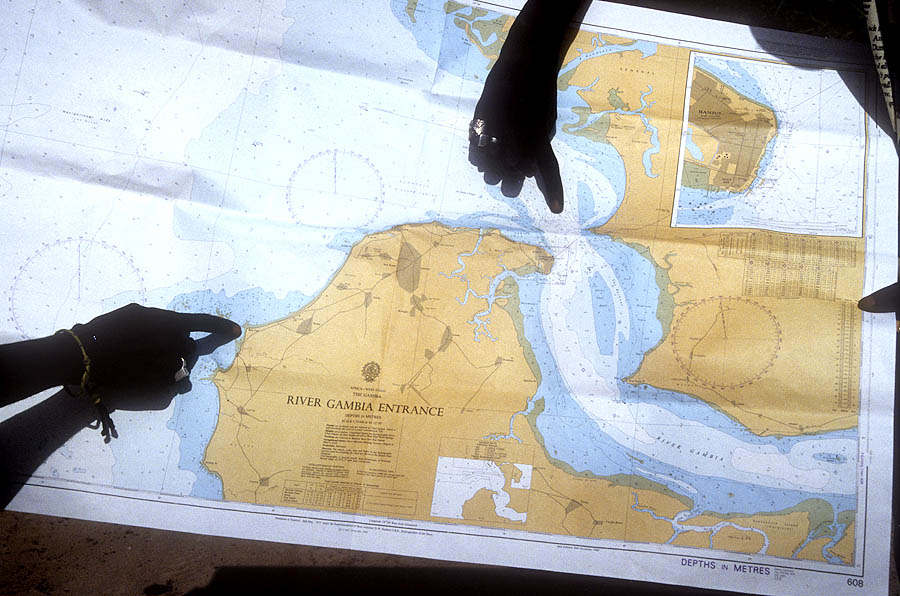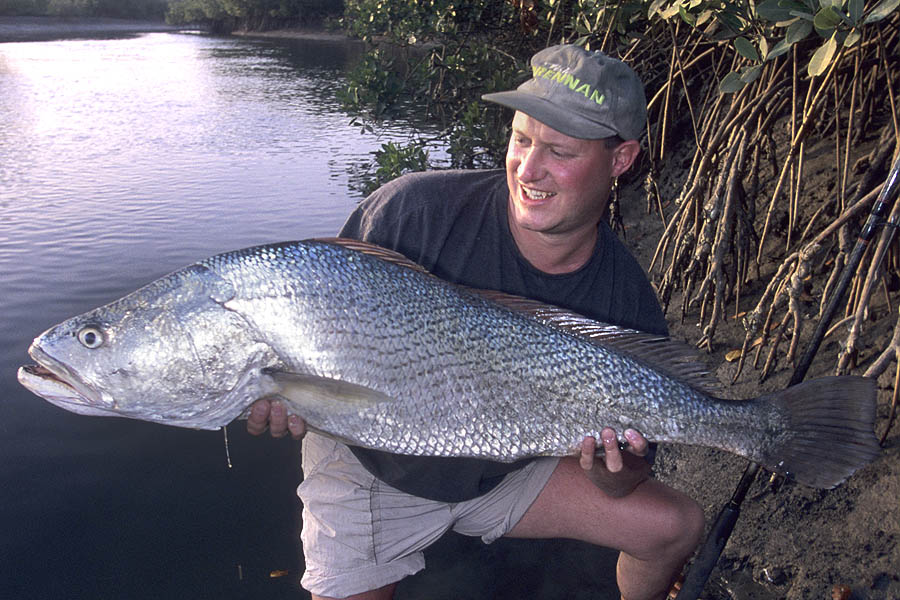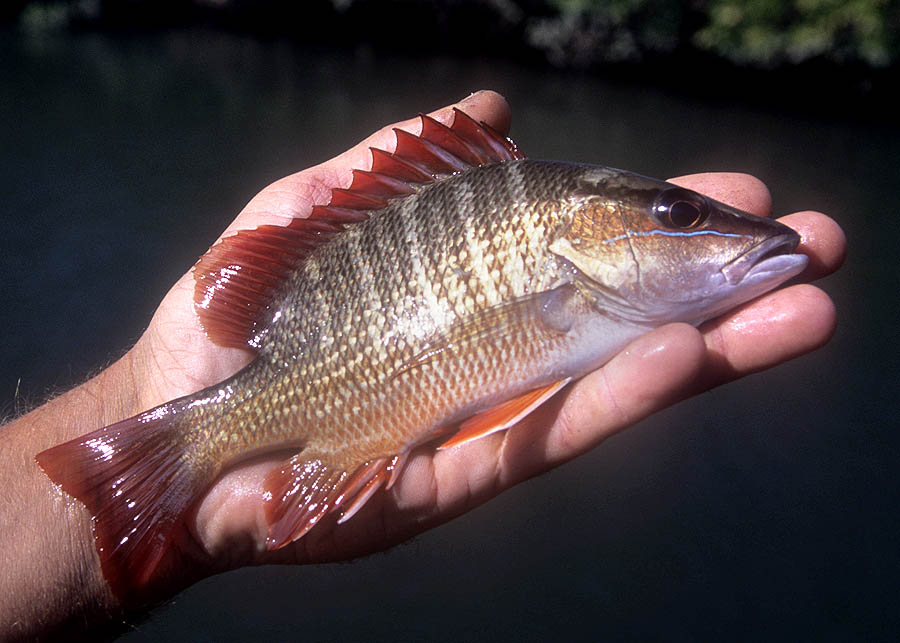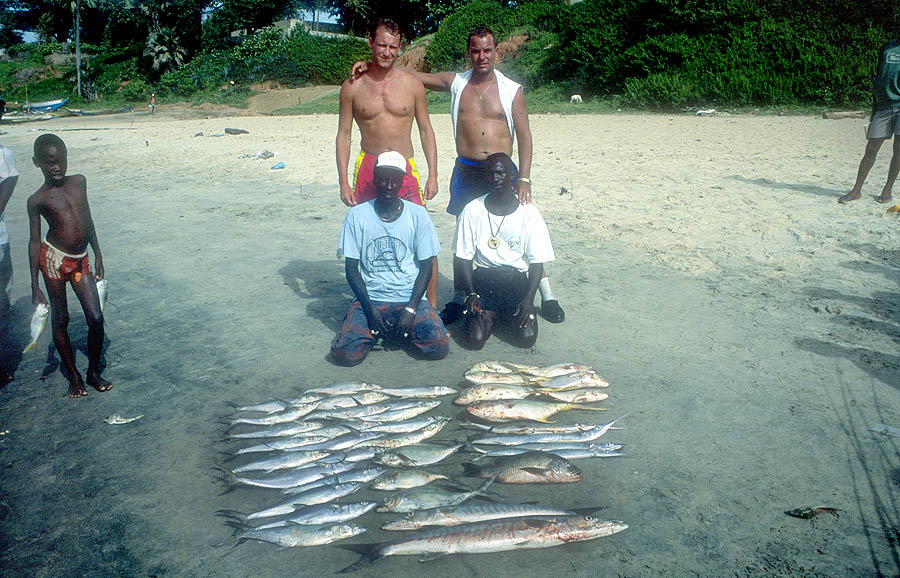 (1992+2000) After an 8 year break from Gambia, it was great to come back. Much was the same as then, but the fishing itself was differently targeted. With the boss from Ju-Ju Williams, Mandy, and Claus Helveg, we tried some different types of fishing, bottom fishing in the Gambia River estuary, bottom fishing along the Gambia coast, bait fishing in the Gambia River mangrove delta and surfcasting from the beaches.
(1992+2000) After an 8 year break from Gambia, it was great to come back. Much was the same as then, but the fishing itself was differently targeted. With the boss from Ju-Ju Williams, Mandy, and Claus Helveg, we tried some different types of fishing, bottom fishing in the Gambia River estuary, bottom fishing along the Gambia coast, bait fishing in the Gambia River mangrove delta and surfcasting from the beaches.
Normal procedure for bottom fishing is to catch baitfish first. Dead bait fish was bought at Bakau fish market, which is well worth a visit, and the live bait fish were fished with herring hangers or sabikis under Denton Bridge.
This type of fishing was almost worth the whole trip. The African sardine was the target, but when you also start pulling up all sorts of other species, it gets your blood pumping. I quickly grabbed the rod from Mandy and set out to reel up several different types of sardines in all the colours of the rainbow; in addition to mullets, baby sea bass and even beautiful specimens of moony fish which would make any aquarium enthusiast drool.
To me, who is particularly interested in the different species (name, family, biology, etc.), it was a true Eldorado. And this was going to get even better in the mangroves, but we'll get to that a little later...
The first few days we fished in the mouth of the Gambia River for red snapper, cassava croaker, long-necked croaker, threadfin and tarpon. We offered the fish both live sardines, live mullets, dead bonga herring and giant prawns, but unfortunately it was spring tide, which colours the water, making fishing for these species difficult.
We saw lots of fish on the fish finder, and also tarpon close to the boat one of the days, but unfortunately they were not interested in the baits, or they did not see them at all. The small sea catfish did, however, which after the first 10 of their species had to be described as pestilences.
It went quite differently on the coast, though.
Along the coast, bottom fishing was not quite as affected by the spring tide. We fished over a reef among other angling boats, but fortunately it was our boat that got by far the most and largest fish. My own bait, which consisted of one live sardine hooked in the back with a size 6/0 single hook, had not been in the water more than a couple of minutes before it was snatched up by the best fish of the trip, a cassava croaker. And just like so many other warm saltwater species, the cassava fought like a creature possessed. For most of the fight the rod tip did not leave the water, the cassava delivered a solid and heavy fight, and when it was finally in the net, it was hard to comprehend that the fish was not at least 10 kilos heavier.
In addition to a few more cassava, we got another croaker species, locally called ladyfish, some different groupers and other sea perch species in quite reasonable sizes.
 Of course, we also got visits from the sea catfish, who took their share of the delicious giant prawns, but just when Claus cursed the catfish, what mostly looked like a sea snake appeared in the surface. To my great pleasure and interest, and Mandy's great relief, it was not a sea snake, but a so-called snake eel, which fortunately is not poisonous. However, the snake eel can deliver an a serious bite, so we treated it with the utmost caution.
Of course, we also got visits from the sea catfish, who took their share of the delicious giant prawns, but just when Claus cursed the catfish, what mostly looked like a sea snake appeared in the surface. To my great pleasure and interest, and Mandy's great relief, it was not a sea snake, but a so-called snake eel, which fortunately is not poisonous. However, the snake eel can deliver an a serious bite, so we treated it with the utmost caution.
On the way back to the Denton Bridge, we trolled for barracudas and jacks. Trolling in warm climates is something quite different from trolling at home, if nothing else then in terms of speed. We whizzed away so I had a hard time grasping that the fish could really keep up. Of course they could, and the other boat in our company got a couple of nice barracudas and some smaller jacks. A few days before, the anglers had caught barracudas of up to 13 kg, and the locals had caught a barracuda of 25 kilos on a giant baitfish. Such a barracuda is well over 2 meters long and has monstrously large jaws packed with sharp teeth. The Rapalas speak their own clear language after a barracuda encounter.
As mentioned before, I was going to get the experience of my life in terms of new and special fish species.
The trip to the mangroves took place on a large African pirogue painted in surreal colours. A pirogue most of all looks like a giant wooden canoe, but the pirogue we fished from was equipped with toilet, guides and engine, in addition to good fishing gear (rod, reels, etc.), bait , food and drinks. It is very simple, you are picked up at the hotel, you do not need to bring anything with you, and then it is even cheap.
The trip lasted approximately 7 hours and I had the time of my life. We fished in different places in the mangrove and everywhere there were lots of fish and lots of different species. We had relatively light gear so any size fish could really be felt. The best bait turned out to be a combination of a single peeled giant shrimp and a piece of fish.
On this we got everything from stingrays, red snapper and groupers, to moony fish, multicoloured spadefish, grunts, surgeonfish, ferocious squid and many other fun species. My camera did not get much of a break on this trip.
In addition to the fish, the mangrove is teeming with life. There are exotic bird species such as rhinoceros birds, ospreys, and several species of kingfishers, storks, pelicans, lots of different crabs, hermit crabs, fiddler crabs and mudskippers.
 The third type of fishing we practiced was surfcasting. We fished from the loveliest bounty beaches just a one hour drive from Bakau, where we stayed. Surfcasting is traditionally super-long-distance fishing, but on the beaches where we fished it was not necessary to cast particularly far. So you do not have to be a long distance expert to get fish.
The third type of fishing we practiced was surfcasting. We fished from the loveliest bounty beaches just a one hour drive from Bakau, where we stayed. Surfcasting is traditionally super-long-distance fishing, but on the beaches where we fished it was not necessary to cast particularly far. So you do not have to be a long distance expert to get fish.
One of the days one of the locals was fishing next to us and he was apparently not interested in getting wet at all so he only went out until the water covered his feet and cast out. He also did not cast very far, and yet he caught fish to over 10 kilos; not bad. However, Claus and I went further out to cast in the hope that it was even better further out.
Let's put it this way: we were never bored! And let me stress that it would be crazy to fish with more than one rod at a time. We had actually planned to place a battery of rods along the beach so that things could really interesting, but we seriously only managed to get a single rod out each before there was action.
First we got threadfins and cassava in the 2-3 kilo class. They fought with great zeal, and at that distance and with a long rod, the fight became so much more fun. Then followed a pair of guitarfish (looks like a mix between stingray and shark, stingray head and shark tail) of approximately 8 kilos, who fought formidably.
The subsequent bites we lost because the trace line was bitten through. In this case, we knew it wasn’t guitarfish, because they don’t have real teeth, only something reminiscent of velcro tape. After several attempts we managed to get the strike right, and then the sinner finally appeared. It was a white-spotted pufferfish with great big teeth. The largest we got weighed over 5 kilos.
We also got a single ladyfish and a couple of nice sompat grunts, and to top it up, Claus got a stingray of over 10 kilos; another epic fight.
The gear we used were 4 meter long surfcasting rods, large spool reels, tube rod holders, special surfcasting/sand leads and large single hooks. Apart from the fact that the fishing on the beach is phenomenally good, it is actually ideal if the family is involved. Who cannot cope with a few hours on a sunny beach.
Every day it was very clear that the tide was the decisive factor for the fishing, and the guides have a great grasp of that. For example, it is essential in beach fishing that you fish at incoming tide and high tides, where the fish come in from deeper water and from the reefs to prey on the smaller fish and crustaceans.
Although we caught a lot of different species in this one week we were there, the opportunity exists to catch far more and larger species, for example tarpon, sawfish, various shark species, butterfly stingrays, ninebone/tenpounder, Senegalese jack, and so many others...
If you have the time and money, there is the opportunity for bluewater biggame fishing for sailfish, wahoo, tuna, mackerel, etc...
As it happens, Gambia can boast of a wealth of IGFA world records.
It's definitely worth a trip to Gambia. It is cheap with a charter flight down there, and then Gambia also offers much more than good fishing (nice food, stable good weather, colourful and friendly people), so bring the family along, they will love it.
